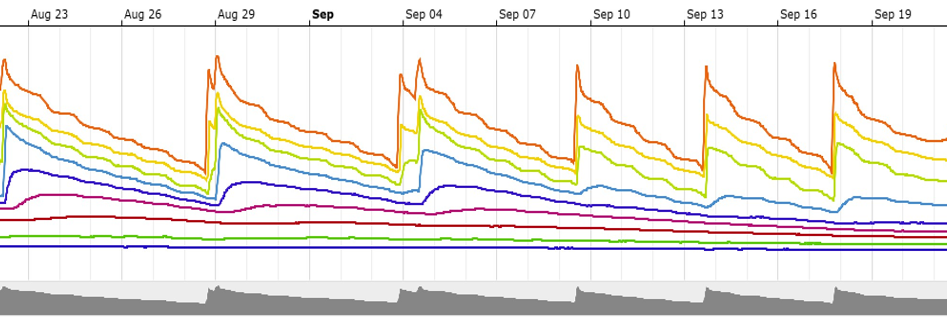Using soil water sensors to automatically schedule irrigation in winegrape vineyards offers the potential for growers to enhance water use productivity under warmer climate conditions
The use of electrical soil water sensors for improving crop water use efficiency is an emerging trend in agricultural regions of the world where irrigation is vital for sustainable food production. This advancement uses solar powered electronic capacitance probes to activate irrigation in real time for maintaining a desired level of soil water content needed by a particular crop.
Automatic irrigation scheduling is achieved by activating pumps and control valves when soil water content falls below a designated level and closing valves after that level is achieved for a set time period.
Successful use of this technological advancement requires the grower to understand the soil water holding capacity, relative water needs of the crop during each stage of its development, and rate of soil water depletion between the irrigation events.
Soil water sensors: A wealth of information
Fortunately, most of this information can be gleaned through a combined examination of charted data and field observation of the irrigated crop. Recorded water content data can be displayed by each depth within the soil profile where a sensor is placed. Commercially available soil moisture probes often have sensors spaced at set intervals within a sealed plastic tube, which is installed into a drilled hole at a representative location within the vineyard.
An electrical cable connects the probe to a nearby data storage module from which data is transmitted to a base server on a regular basis via cell phone. Stored data can be selected for observation or analysis during a desired period of the growing season and adjustments made to the irrigation set points or the particular sensor depth selected as the sentinel activator of water applied.
In addition to measuring soil water content, other types of soil water sensors called “tensiometers” can determine the matric potential at which soil water is being held within a specific soil type. This sensor can be paired with a soil water content probe to estimate the amount of water which is available to the vine. As water is being withdrawn from the soil by the vine, the matric potential or holding power of the remaining soil water becomes stronger. This tension may create a water stress effect on the vine.
Growers often apply less water than the vine normally uses to impart a moderate level of water stress on the vine. This practice is known as ‘deficit irrigation’ and is typically applied between fruit set and full maturation. This practice has been found to enhance grape quality over well-watered vines.

Growing quality grapes
Within the interval between typical irrigation events, the grapevine may be subject to water stress for only a short period of time before application of the next irrigation. The use of automated irrigation may be able to hold the vine in an extended state of moderate water stress by delivering pulses of irrigation of short duration at increased frequency as opposed to higher volume applications over longer time intervals.
This strategy may have the potential for maintaining yields while saving water and enhancing grape quality. Research studies in commercial vineyard locations are being conducted currently by the author and cooperating growers and colleagues across several locations within the U.S. Pacific Northwest and could soon be expanded to other regions of the western U.S.
Automated, sensor-driven irrigation scheduling, when coupled with subsurface irrigation delivery, may be especially effective in conserving water while maintaining yields in arid winegrape growing regions. Most drip irrigation systems currently used by growers in the western U.S. deliver water to the soil surface, resulting in water loss through evaporation and use by broadleaf and grassy weeds.
High frequency, short-duration irrigation that is mentioned in the preceding paragraph could result in more water loss and higher power costs if used with surface drip application rather than subsurface drip. This concern needs to be examined through controlled and replicated field research; however, conventional wisdom would support greater evaporative loss, assuming that water applied more frequently to the surface did not infiltrate beyond the upper 30-45cm of the soil surface.
Additionally, automated, sensor-driven irrigation could reduce the waste of water that may occur from overwatering after the soil becomes saturated. Data displayed in Figure 1 above illustrates overwatering occurring in the upper soil profile before 7 September, when automated irrigation was activated. Figure 2 above compares soil water matric potentials under surface and subsurface drip with dark portion at the bottom representing the relative amounts of potential stress imposed on the vine.

This work is licensed under Creative Commons Attribution-NonCommercial-NoDerivatives 4.0 International.


